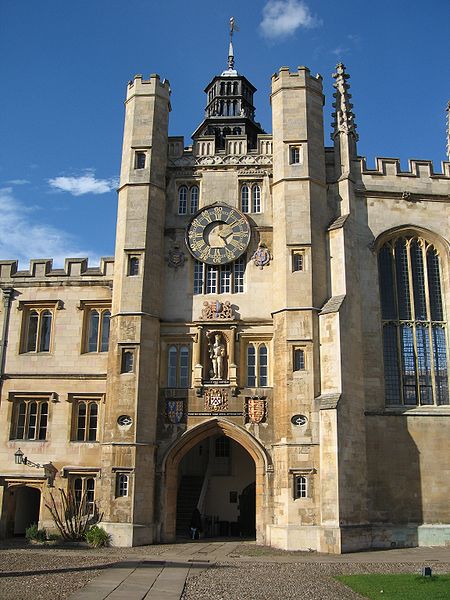
Clock Tower, Trinity Great Court
If you through the regions of space should have travelled,
And of nebular films the remotest unravelled,
You'll find as you tread on the bounds of infinity,
That God's greatest work is --- the Master of Trinity.
--Sir Francis Doyle.
From a leaflet published in 1838 (reprinted in Charles Whibley, ed., In Cap and Gown [London: Heinemann, 1898]):
EXTRAORDINARY ASTRONOMICAL DISCOVERY AT THE CAMBRIDGE OBSERVATORY
"A REMARKABLE and interesting discovery has just been made at the Cambridge Observatory, by means of the splendid telescope recently fitted up there, the liberal gift of a noble and munificent Duke ; nor is the ingenious method pursued in bringing this wonderful phenomenon to light less remarkable than the novelty of the appearance of a body, whose existence, though frequently suspected, had never been satisfactorily established.

"It had long been supposed, that in addition to the many small planetary bodies which revolve at various distances round the glorious and brilliant sun of Trinity College, and which are commonly known by the name of minor establishments, or small colleges, there might be some so small that their existence had never become known to any member of Trinity.

"This idea received great support from the learned researches of the talented astronomical observer, Professor Challis. In his paper "On the True Law of Collegiate Distances," published in the Transactions of the Cambridge Philosophical Society, he had demonstrated the numerical law which regulates the distances of the small colleges from the centre of the system. At the same time he found that this law was in default in one place, as the distance between Sidney and Jesus was greater than that assigned by calculation. He conceived, therefore, that it was highly probable that another college would be found somewhere in the interval.

"He had accordingly searched long and carefully with the instruments which he then possessed, but always without success, as their strength was not sufficient to exhibit a body which now is known to be of so small a size, and to shine with so feeble a light.

"But as soon as the magnificent gift of the noble Duke was in a state fit for working, he employed it with indefatigable zeal in the search of this long suspected body.
"His efforts have now been crowned with success ; and no greater proof need be given of the excellence of this wonderful telescope, than the fact of its having been able to detect a body so small that it had eluded the observation of all previous astronomers.
 Photo: Steve Cadman
Photo: Steve Cadman
"This new body, which the researches of Professor Challis have added to our system, is by far the smallest known, being about one-half of the size of Sidney. The ratio of its mass to that of Trinity, considered as unity, is ⋅0000000012.

"It has a dull leaden colour somewhat like St. John's, and though its inhabitants have not yet been distinctly seen, from sundry considerations they are conjectured to be of less size than even those men of Emmanuel who have been seen.
 Graphic: McAnt
Graphic: McAnt
"These are all the particulars the learned Professor has as yet been able to determine, but he is now employed in investigating the latitude and longitude of its Hall and Chapel, if indeed it do possess the latter. He conceived at one time that he heard the sound of an organ, but as this is an appendage unknown in any of the existing small colleges, it is conjectured that so remarkable a deviation from the usual nature of these bodies has no foundation in fact.
"Never since the discovery of Olbers was there so great an excitement among astronomers, as when the learned Professor announced his discovery ; and they are all now diligently employed in searching the whole heavens in expectation of finding another of these bodies, but as yet without success. The highest credit is due to Professor Challis for the ingenuity of reasoning by which he arrived at the conclusion that such a body did exist, and the dexterity by which he verified his suspicions ; and his name will be handed down to posterity with those of Herschel, Olbers, and Piazzi, as one of those who have done most for astronomical science."

Graphic: Alberto ECJ
EPILOGUE: This moderately amusing leaflet is supposed to have been written in 1838. It would have been much more topical three or four decades later.
More topical, firstly, to Cambridge. In 1838, Cambridge's youngest college (by about 200 years) was Downing, established in 1800. Although Downing's buildings do not seem to me to match the leaflet's description very closely, the references to Jesus and Emmanuel Colleges (the next youngest, established 1596 and 1584) suggest that the thirty-eight year old upstart might have been the new planet the author had in mind. But from 1869 on, more and more new colleges appeared at the University (in part to accomodate women, lower-class students, and other persons traditionally excluded). Not surprisingly, these new institutions attracted the attention of satirists.
More topical also for James Challis: in 1846, he and his more famous predecessor at the Observatory, George Biddell Airy, would take the blame for one of the greatest national embarassments in the history of British astronomy: by making no attempt to verify the predictions of their colleague John Couch Adams, they would allow Germans to discover Neptune. But there was more to Challis than this: we will meet him again in a future installment of this site's series entitled "The Nineteenth-Century War between Physics and Biology".